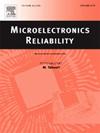通过先进的金属层技术优化无掺杂 TFET 性能的可靠性
IF 1.6
4区 工程技术
Q3 ENGINEERING, ELECTRICAL & ELECTRONIC
引用次数: 0
摘要
为了解决无掺杂 TFET 的低导通电流和可靠性问题,我们在源极/沟道(S/C)界面附近加入了一层金属层。这种金属层的使用有利于在结点附近产生更大的电子流,从而帮助导通电流(ION)在较低的偏置条件下超过 10-4 A/μm 。ION 的增强改善了模拟、射频和线性应用中的各种性能指标。此外,为了评估可靠性,我们分析了受体和供体电荷对 DL-MS-TFET 的影响,重点是界面附近的陷阱效应(ITC)。结果表明,这些陷阱电荷的存在会显著影响平带电压,导致 DL-MS-TFET 的性能变化减小。此外,我们还观察了金属带功函数对直流性能特性的影响。随着金属层功函数的增加,导通电流明显下降。总之,无掺杂 MS 的 TFET 在存在 ITC 的情况下表现出卓越的性能,使其适用于低电压和模拟射频应用。本文章由计算机程序翻译,如有差异,请以英文原文为准。
Reliability optimization of dopant-free TFET performance through advanced metal layer techniques
To address the low ON-current and reliability issues of dopant-free TFETs, we have incorporated a metal-layer near the source/channel (S/C) interface. The use of this metal layer facilitates a larger flow of electrons near the junction, which helps the ON-current () exceed 10−4 A/ under lower biasing conditions. This enhancement in improves various performance metrics in analog, RF, and linearity applications. Furthermore to assess dependability, we analyzed the impact of acceptor and donor charges on the DL-MS-TFET, focusing on trap effects near interface (ITCs). The results reveal that the presence of these trap charges significantly affects the flat-band voltage, leading to reduced variations in the performance of DL-MS-TFETs. Furthermore, we observed the influence of the metal strip work function on DC performance characteristics. A noticeable decrease in ON-current was found as the metal layer work function increased. Overall, the MS-dopant-free TFET demonstrates superior performance in the presence of ITCs, making it suitable for low-voltage and analog-RF applications.
求助全文
通过发布文献求助,成功后即可免费获取论文全文。
去求助
来源期刊

Microelectronics Reliability
工程技术-工程:电子与电气
CiteScore
3.30
自引率
12.50%
发文量
342
审稿时长
68 days
期刊介绍:
Microelectronics Reliability, is dedicated to disseminating the latest research results and related information on the reliability of microelectronic devices, circuits and systems, from materials, process and manufacturing, to design, testing and operation. The coverage of the journal includes the following topics: measurement, understanding and analysis; evaluation and prediction; modelling and simulation; methodologies and mitigation. Papers which combine reliability with other important areas of microelectronics engineering, such as design, fabrication, integration, testing, and field operation will also be welcome, and practical papers reporting case studies in the field and specific application domains are particularly encouraged.
Most accepted papers will be published as Research Papers, describing significant advances and completed work. Papers reviewing important developing topics of general interest may be accepted for publication as Review Papers. Urgent communications of a more preliminary nature and short reports on completed practical work of current interest may be considered for publication as Research Notes. All contributions are subject to peer review by leading experts in the field.
 求助内容:
求助内容: 应助结果提醒方式:
应助结果提醒方式:


